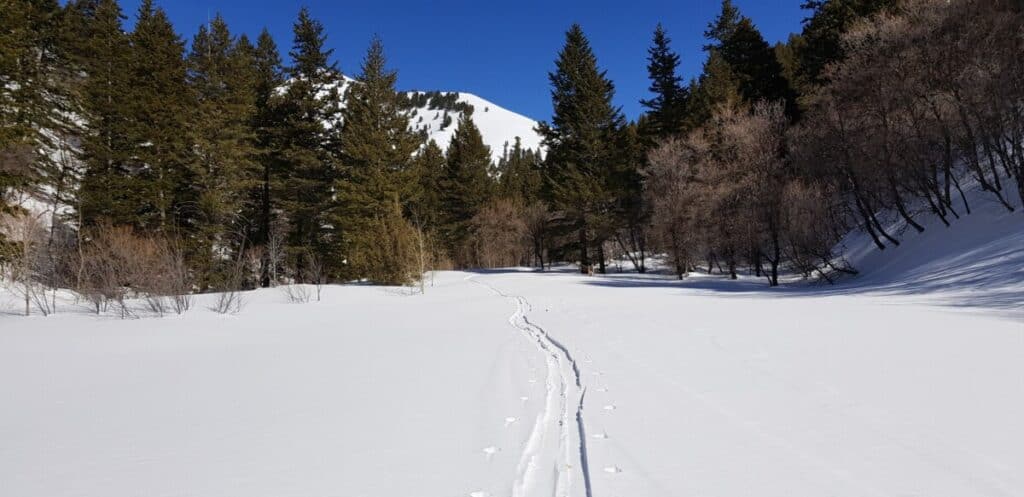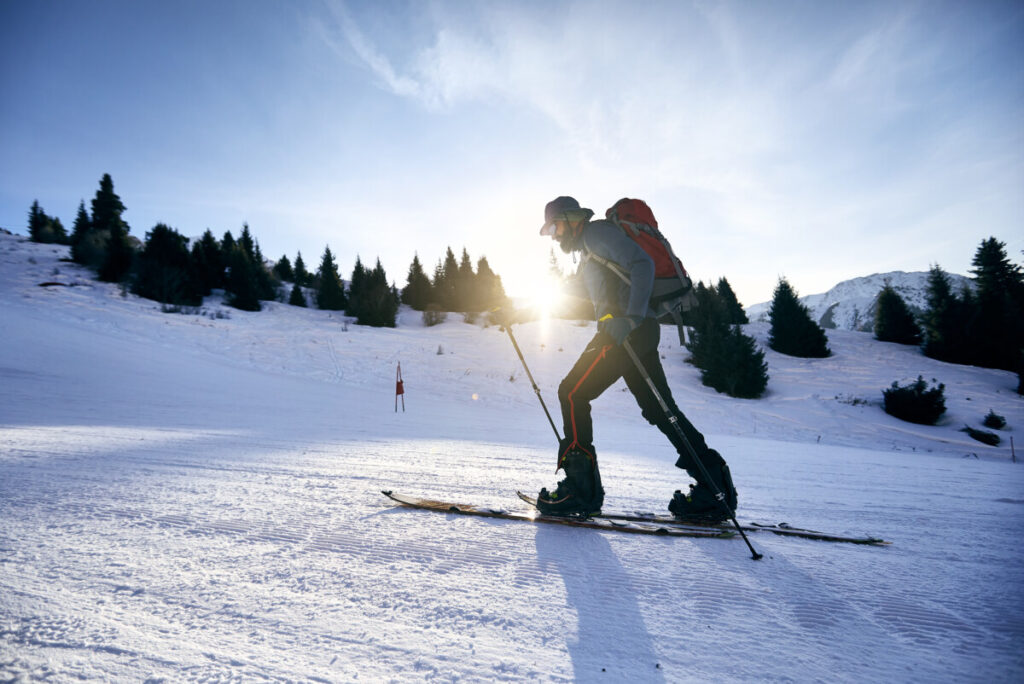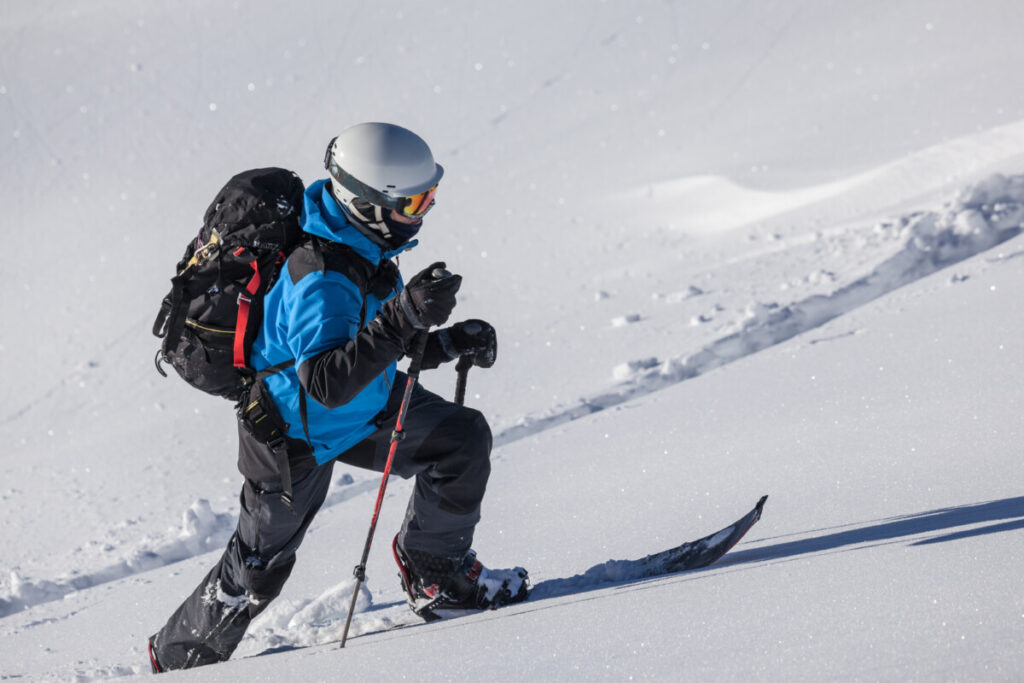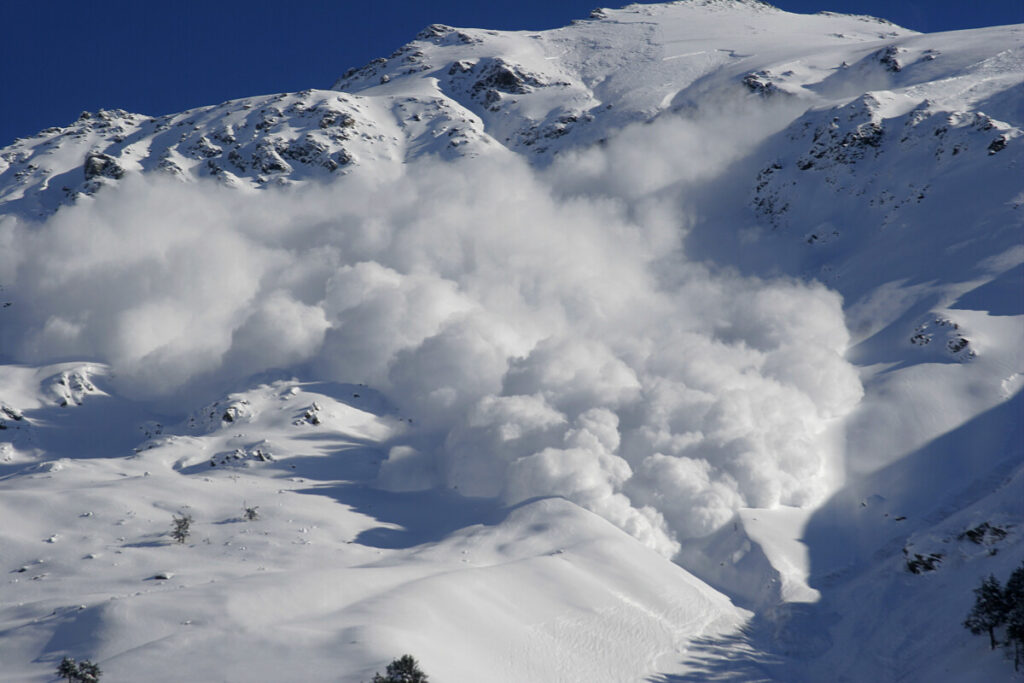
For those who want to experience the backcountry for the first time–with NO backcountry gear, NO backcountry skiing experience, nada! Just a friend gung ho about getting you out there, dreams of pow, and an itch to try something new and exciting. . .where do you even begin? With so much to consider about backcountry gear and avalanche risks, getting started can feel overwhelming and rightfully justified.
To get an idea what it is like backcountry skiing, you don’t have to spend a lot of money on new equipment or have an in-depth knowledge on avalanche safety. Instead, rent or borrow gear and plan a tour with an experienced partner inside the uphill-travel boundaries at your local ski resort.
An environment outside the boundaries of the ski resort that is not patrolled or avalanche regulated is considered to be backcountry or off-piste terrain. Regardless of whether the backcountry is accessed just outside the resort boundaries (side-country) or in remote wilderness areas, the backcountry traveler takes full responsibility for their endurance capabilities, health, safety and avalanche risk mitigation and rescue. When traveling in the backcountry, it is critical to have proper gear, know how to use it, and to be knowledgeable about avalanche risk assessment, aversion and rescue.
Uphill Travel at the Ski Resort: The Best Way to See If Backcountry Skiing is Right for You

As you can imagine, there is a lot of knowledge and equipment needed in order to be properly trained and prepared for backcountry travel. How and where can you get started. Obviously, dropping thousands of dollars on new equipment and spending hours and hours of training just doesn’t make sense for someone who doesn’t even know if it is something they will enjoy or want to commit to.
The good news is that there is a way to cut your proverbial teeth into backcountry-like travel without dropping the doe and without getting avalanche trained. It’s at the ski resort.
Many ski resorts accommodate “uphill travel” and have specific routes to ascend before, after, or during operating hours—depending on the resort. This is the perfect place to get an idea what it is like backcountry skiing. Check the web for resorts near you to find uphill-travel accommodations.
Be sure and check for your resort’s uphill-travel black-out dates and for potential day-of warnings and restrictions. Also, check for weather conditions that may impact your resort’s uphill-travel policy.
Cross Country Trails: a Great Place to Test Backcountry Gear
Don’t be shy about trying a backcountry setup in a designated cross country ski area.
Some cross country ski areas contain several miles of gentle-sloped groomed trails. Avalanche risk on a groomed cross country trail is usually minimal. This is a safe place to become familiar with backcountry equipment and practice technique. Skin up, transition, lock in the heels, and cruise out.
A five or six mile tour on a cross country groomer can also be a great way to identify and resolve gear issues. Believe me, sorting out gear issues on a groomed trail is far more ideal than being forced to deal with a gear problem several miles out in the middle of nowhere in the backcountry.
Familiarize with Alpine Touring Equipment
While on initial backcountry setup outings, you’ll be able to familiarize yourself with an alpine touring or splitboard setup. You will be able to experience what it’s like touring. You’ll learn how to attach and remove your skins. . .how to step in and out of your bindings. . .how and when to adjust the heel riser on the bindings when navigating in and out of steep terrain. . .how to kick-turn up and around a switch back. . .how to transition from uphill travel to ski mode, etc.
Gage Endurance Capabilities: Alpine Touring is a Very High Endurance Workout

During your first few sessions of uphill travel within the resort boundaries, you’ll get to taste some of the difficulties of backcountry skiing. Your legs will get tired on the approach. Downhill skiing or snowboarding on spent legs and being back-end heavy with a loaded pack is a whole lot different than the laps taken off the ski lift.
You may have to make significant technique adjustments because everything will feel different: powder turns, jump-turns in steep terrain, carving through ice and crud…all of the variable snow conditions may feel more challenging. It’s not uncommon to find thick and thin powder stashes, crusted snow patches, choppy crud and crude ice all in one downhill line in the backcountry. Needless to say, not only is it more challenging to ski being back-end heavy with even a light pack, transitioning through variable snow conditions can be extremely challenging and exhausting.
There is no way to sugar coat it. . .backcountry skiing is hard work. A common tour could be 90% strenuous uphill touring with the 10% downhill on typically variable snow (every now and then on epic powder). With that in mind, it goes without saying, backcountry skiing isn’t for everyone. However, for many, the endorphins released during strenuous uphill travel combined with the adrenaline high from downhill turns all while saturated in isolated winter mountain bliss is second to none.
Assess Endurance and Risk Tolerance
While in the resort, it is important to tour and ski a range of slope angles and steepness. Carefully assess your capabilities to determine which types of terrain you feel comfortable touring and skiing. You’ll want to use this as a basis for route planning if/when you decide to tour in the backcountry.
Ask your experienced ski partner every question that comes to mind. Begin building a mental picture of what it’s like in the backcountry and what types of decisions and situations you may face. Position yourself in those potential settings to start building an idea of what type of backcountry skier you are.
When touring and skiing in the backcountry, it is important to be accompanied with like-minded people who share similar risk tolerances and endurance capabilities so that decisions can be made in sync.
Whatever you do, don’t let your friends pressure you into going on a powder hunt in the steeps for your first trip into the backcountry. There are a lot of nuances associated with backcountry gear, steep uphill touring, skiing, gear organization, etc. that you can become familiar with while testing things out in the safe controlled environment of the ski resort. Ideally, it is here where you’ll be able to gage your risk tolerances and endurance capabilities. These are important factors that you will be able to rely on when making critical decisions out in the real backcountry. You will also get a pretty good idea about whether or not you want to pursue your interest in the backcountry.
Getting Started into Backcountry Skiing? Gear Up! And, Get Trained!
Once you’ve become acquainted with the formalities of backcountry skiing in a safe and controlled environment and feel eager to explore the backcountry at a low risk level, it’s time to start gearing up and learn about avalanche safety.
Gearing up can be very expensive. However, starting your gear-up plans with an idea of how much time you and your setup will be in the backcountry vs. the resort can help direct your purchases and potentially save you a whole lot of money. See my post: Gearing Up for Backcountry Skiing is Not as Overwhelming as it May Seem, to learn more about how to make purchase decisions that will pair best with your anticipated skiing behavior.
Why You Must Get Avalanche Safety Training

One of the greatest challenges in the backcountry is being able to identify, anticipate, plan for, and mitigate avalanche risk. The maximum capacity at which the snowpack on a particular slope angle can maintain stability is always uncertain. Even if a backcountry route incorporates low slope angles, a plethora of different snow conditions and risk variables are inherent in the backcountry.
An in depth understanding of avalanche risk assessment, avalanche rescue training, and other risks associated with backcountry travel must be acquired.
I highly recommend taking the AIARE 1 course. The American Institute for Avalanche Research and Education offers a 3 day training course (AIARE 1) that will help you learn more about avalanche danger. The program teaches how to read the snowpack, how to identify weak layers in the snow, how to read avalanche forecasts, how to identify high-risk terrain conditions, how to route plan, how to identify snow anchors, how to recognize terrain traps, and how to coordinate and respond in an avalanche victim recovery situation.
The course is jam-packed with incredible resources. In fact, I personally think this course should be a required prerequisite for anyone and everyone who ventures into the backcountry.
Think of the AIARE 1 course as Driver’s Ed. It’s required before obtaining a driver’s license. No one, regardless of how much experience they already have driving, is legally able to drive until they’ve taken Driver’s Ed and passed the test. Those who take Drivers Ed and pass the test, in essence, individually acknowledge their understanding and comprehension of the driving laws and standards established to enhance safe driving conditions for everyone.
Similarly, the AIARE 1 course sets a fundamental foundation to enable members of the backcountry community to be on the same page when planning route objectives, assessing avalanche conditions, making inroute decisions, and responding to avalanche situations.